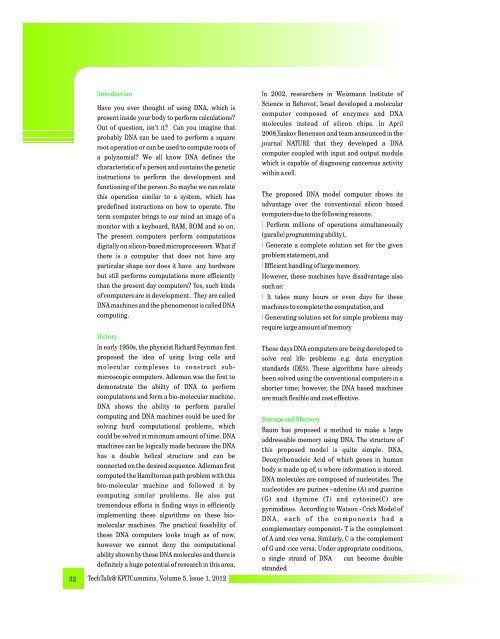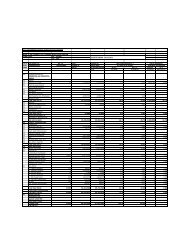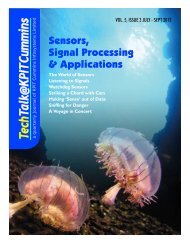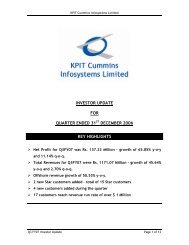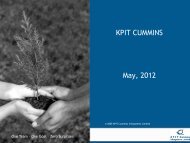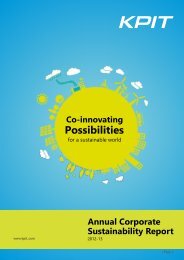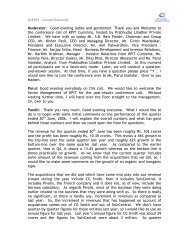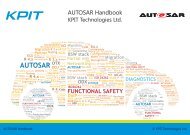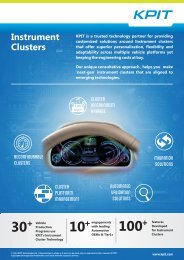INNOVATIONS FROM THE EDGE - KPIT
INNOVATIONS FROM THE EDGE - KPIT
INNOVATIONS FROM THE EDGE - KPIT
You also want an ePaper? Increase the reach of your titles
YUMPU automatically turns print PDFs into web optimized ePapers that Google loves.
Introduction<br />
Have you ever thought of using DNA, which is<br />
present inside your body to perform calculations<br />
Out of question, isn't it Can you imagine that<br />
probably DNA can be used to perform a square<br />
root operation or can be used to compute roots of<br />
a polynomial We all know DNA defines the<br />
characteristic of a person and contains the genetic<br />
instructions to perform the development and<br />
functioning of the person. So maybe we can relate<br />
this operation similar to a system, which has<br />
predefined instructions on how to operate. The<br />
term computer brings to our mind an image of a<br />
monitor with a keyboard, RAM, ROM and so on.<br />
The present computers perform computations<br />
digitally on silicon-based microprocessors. What if<br />
there is a computer that does not have any<br />
particular shape nor does it have any hardware<br />
but still performs computations more efficiently<br />
than the present day computers Yes, such kinds<br />
of computers are in development. They are called<br />
DNA machines and the phenomenon is called DNA<br />
computing.<br />
History<br />
In early 1950s, the physicist Richard Feynman first<br />
proposed the idea of using living cells and<br />
molecular complexes to construct submicroscopic<br />
computers. Adleman was the first to<br />
demonstrate the ability of DNA to perform<br />
computations and form a bio-molecular machine.<br />
DNA shows the ability to perform parallel<br />
computing and DNA machines could be used for<br />
solving hard computational problems, which<br />
could be solved in minimum amount of time. DNA<br />
machines can be logically made because the DNA<br />
has a double helical structure and can be<br />
connected on the desired sequence. Adleman first<br />
computed the Hamiltonian path problem with this<br />
bio-molecular machine and followed it by<br />
computing similar problems. He also put<br />
tremendous efforts in finding ways in efficiently<br />
implementing these algorithms on these biomolecular<br />
machines. The practical feasibility of<br />
these DNA computers looks tough as of now,<br />
however we cannot deny the computational<br />
ability shown by these DNA molecules and there is<br />
definitely a huge potential of research in this area.<br />
32 TechTalk@<strong>KPIT</strong>Cummins, Volume 5, Issue 1, 2012<br />
In 2002, researchers in Weizmann Institute of<br />
Science in Rehovot, Israel developed a molecular<br />
computer composed of enzymes and DNA<br />
molecules instead of silicon chips. In April<br />
2008,Yaakov Benenson and team announced in the<br />
journal NATURE that they developed a DNA<br />
computer coupled with input and output module<br />
which is capable of diagnosing cancerous activity<br />
within a cell.<br />
The proposed DNA model computer shows its<br />
advantage over the conventional silicon based<br />
computers due to the following reasons.<br />
l Perform millions of operations simultaneously<br />
(parallel programming ability),<br />
l Generate a complete solution set for the given<br />
problem statement, and<br />
l Efficient handling of large memory.<br />
However, these machines have disadvantage also<br />
such as:<br />
l It takes many hours or even days for these<br />
machines to complete the computation, and<br />
l Generating solution set for simple problems may<br />
require large amount of memory<br />
These days DNA computers are being developed to<br />
solve real life problems e.g. data encryption<br />
standards (DES). These algorithms have already<br />
been solved using the conventional computers in a<br />
shorter time; however, the DNA based machines<br />
are much flexible and cost effective.<br />
Storage and Memory<br />
Baum has proposed a method to make a large<br />
addressable memory using DNA. The structure of<br />
this proposed model is quite simple. DNA,<br />
Deoxyribonucleic Acid of which genes in human<br />
body is made up of, is where information is stored.<br />
DNA molecules are composed of nucleotides. The<br />
nucleotides are purines –adenine (A) and guanine<br />
(G) and thymine (T) and cytosine(C) are<br />
pyrimidines. According to Watson - Crick Model of<br />
D N A , e a c h o f t h e components h a d a<br />
complementary component- T is the complement<br />
of A and vice versa. Similarly, C is the complement<br />
of G and vice versa. Under appropriate conditions,<br />
a single strand of DNA can become double<br />
stranded


